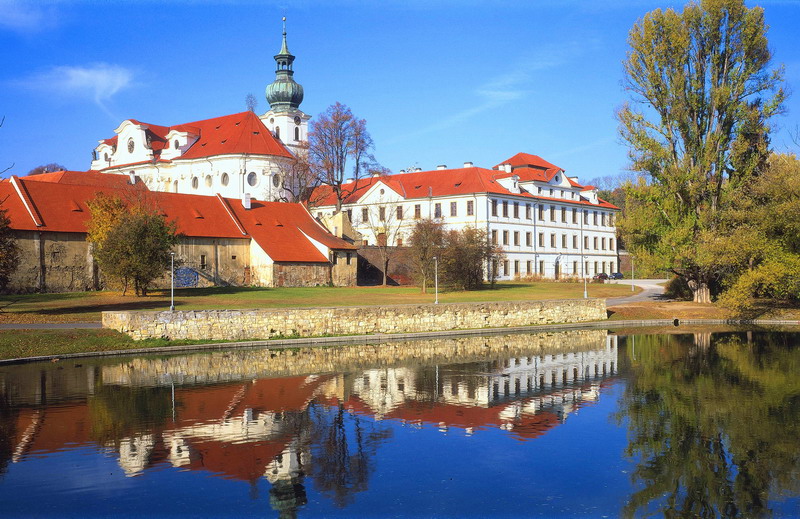
White Mountain – Eternal Peace and Heartbreaking Loss
If you are staying in Prague for more than two days, an often neglected place that is well worth a visit is the Břevnov Monastery, located right next to the White Mountain pilgrimage route.
The origins of the monastery date back to 993 CE. The monastery was founded by St. Adalbert, Bishop of Prague, and Prince Boleslav II. Both were ardent believers, as this was the first monastery to be erected on Czech soil. The Břevnov Monastery is associated with a mystic legend. Within its grounds is a very special well named “Vojtěžka”. It is said that whenever tragedy is soon to strike, the water in the well turns cloudy, to alert those nearby to the impending misfortune. The monastery complex contains several beautiful and historic structures, including the baroque Basilica of St. Margaret, a Romanesque crypt from the 11th century, and a baroque prelature with a Teresian hall. In addition, there is a lovely monastery garden, which has been refined several times over the centuries. The lower section of the actual monastery, is open to the public daily from 6:45 to 8:00 p.m., though pavilion Vojteska, which according to a legend was the meeting place of St. Adalbert and Prince Boleslav, is accessible only on the guided tours.
If you are not too tired after visiting the monastery and are interested in historical warfare, to the west of the Břevnov Monastery there is a large park called “Hvězda”, where on 8 November 1620 a bloody battle took place between the army of the Kingdom of Bohemia and the armies of Emperor Ferdinand II. There every last individual of 7,000 men was slaughtered. Later, the 27 leaders of the rebellion were imprisoned and subsequently executed on June 21, 1621, at the Old Town Square. “Battle at the White Mountain” has decided about the future of our country for three upcoming centuries. This battle witnessed countless torture, suffering and death. The Czech kingdom became part of the Habsburg Empire and the forced re-catholization process started.
A simple stone memorial erected in 1920 at the highest point of Prague (381 m.) reminds the battle which took place here on November the 8th 1620. Whoever walks at the White Mountain can feel disturbance and discomfort. There, around the walls of the battlefield, can be heard the sobbing of Moravian soldiers who were trying to resist, fighting bravely to the end, while the other comrades ran away a long time before, knowing that the battle was already lost.

According to a legend, a young Swedish count Tor wanted to feel the glory and honor of a soldier so he had himself recruited. Before coming to Bohemia he traveled wide and far and when he was passing through Holland he met a beautiful woman Josefína. She begged him to stay with her in Holland but a young soldier had already decided before. Josefina, when she realized that weeping was pointless, joined him on his journey. They were heading towards Prague. Tor was killed in a battle. For a long time was Josefina looking for the body of her beloved Tor. A few steps from the Summer Palace his body was lying still. He was on his back, his eyes were closed. She sat on the ground, held his head on her lap and waited for corpse collectors. Tor was buried by the wall of Summer Palace. Josefina was sitting there for several days. She did not eat, or drink anything. Some time later she got up and walked away. Nobody has ever seen her again. A year later a rose grew out at the Tor’s grave. The following year it grew bigger. Soon it became a big shrub, flowering every year. The rose grows for centuries, not even freezing winters killed it. Anyone who tries to destroy or cut the rose will be met with misfortune: accident, illness and death.
The same Summer Palace where Tor’s body lay dead is itself a place of mystery and magic. Designed and constructed by Archduke Ferdinand Tyrolský in 1555-56, the entire structure is rich with symbols. The ground plan is in the form of a six-pointed star (hexagram), which symbolizes the connection between two opposite forces in mutual harmony. It is known that sensitive people feel a special energy in hexagrams. The middle of the Summer Palace contains such heightened energy that it swings a pendulum and turns the Divining rod. The hexagram is constructed of two equilateral triangles overlapping each other. The upper triangle symbolizes fire, and the lower symbolizes water. What is more interesting is that these two elements can be found in the decoration of the interior of the Summer Palace. The underground is decorated with images of earth, on the ground floor there are images of water, the first floor is devoted to the air, and the top (second) floor depicts fire.
Recognizing its power, the National Literature Memorial obtained the structure and it is currently used as an exhibition hall. Expositions at the deepest level offer a model of the Battle at the White Mountain and engravings with the same theme. The floor above it hosts an informative exposition about the construction, development and history of Hvězda, including a video projection about the Summer Palace and a section dedicated to Alois Jirásek and Mikoláš Aleš.
The first floor invites visitors to see the “Time Memoranda” exhibition – including articles and writings from the fine collections of the National Literature Memorial.
To get to both places, take Tram #22 in the direction of “Bílá hora“, which is conveniently accessible right from Prague City center, metro stop Malostranska on “A” line.